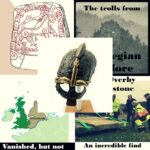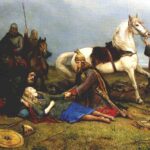In the Baltic ocean, on the southeastern side of the island Öland in Sweden, lie the remains of a ringfort. It was active within just a short period of the Iron Age over 1500 years ago. Within this ringfort, archaeologists have recently discovered treasures such as gold, coins, jewelry, and glass beads that nobody has touched for over a thousand years. Unique trade goods, such as Sweden’s oldest glass workshop, was also uncovered here. With all of these exclusive objects scattered within the ruins of the ringfort, it is a believable assumption that the ringfort inhabitants were not only rich, but also powerful people within their society. This conclusion is further strengthened by the finds of exclusive brooches, which would have belonged to the elite. It was therefore a surprise, to say the least, when piles upon piles of bodies were uncovered alongside all of the treasure. Man and beast alike lay dead in the street, undisturbed for over a millennium. People had been struck down and left for dead, their animals had starved to death, and the ringfort had never been revisited until modern times.
Calling Sandby Ringfort the “Pompei of Sweden” is not entirely accurate; there was no volcanic eruption, nor was there ash smothering people to death. But it does paint a vivid picture of what it was like to excavate this site, as it truly is a moment frozen in time. Dead members of a social group are often buried in some way, and animals are loved, cared for and utilized as a resource. Treasures are often plundered, and ringforts are reinhabited in later periods. This did not occur at Sandby; in fact, not even food was cleared off the table. Most archaeological sites display evidence of continuous use until the gradual abandonment, rather than suddenly being cut off. At Sandby, however, Time simply stopped one day. It was on this day that the lives of perhaps as many as three hundred people ended, brutally, and their bodies left to rot. No one returned to bury their dead, nor to loot the corpses and the scattered valaubles. Freshly made food laid out on tables half-eaten, indicating that people had been interrupted in their daily chores, and while this tragedy is simply horrific, it provides us with a snapshot of the past that we rarely get to see.

Time period
“With the fall of Rome, much of the trade was cut off and disrupted, and political destabilization. This increased the tension across Europe and led to poverty, forcing people to migrate.”
Sandby was active during the Migration period, which was part of the Iron Age. This period is dated to between 400 to 550 A.D. in Sweden, and it may be an important piece of the puzzle as to why the massacre occurred in the first place. The Migration Period, as the name entails, was a point in time in which there was a lot of movement surrounding large groups of people. Entire populations would end up migrating to a new place and would sometimes permanently settle there, changing the map of Europe in the process. But change rarely occurs without a spark. The Migration period contained many migrations because it was an incredibly tumultuous time, in which many previously habitable places became hostile or unlivable. The Roman Empire famously fell in year 476 AD, and with this came war and famine. With the fall of Rome, much of the trade was cut off and disrupted, and political destabilization. This increased the tension across Europe and led to poverty, forcing people to migrate.
The island Öland in southeastern Sweden had strong international connections during the Roman Iron Age (the period preceding the Migration Period). Many inhabitants of this small island became fairly wealthy through these connections, and likely brought a lot of coin back from long voyages. This theory can be verified by looking not only at the vast amount of coin found on the island, but also by looking at a world sensational object: the oldest glass workshop in Sweden. Finding a glass workshop at Sandby was like finding a TV in an 18th century house – a joke commonly told by Helena Victor, the project leader at Sandby, as she holds seminars or tours of the famous site.
But when the Roman Empire fell, much of the trade suddenly ceased, and with this, much of the incoming gold. This likely became a very stressful and intense situation for many of the inhabitants at Öland, but this stress was also very real through the rest of Europe. This tension would become the buildup for many conflicts, which later came to characterize the Migration period as an epoch. How large a part the fall of the Roman Empire actually played in the destruction of Sandby and its inhabitants is impossible to say, but it is likely that it at least created ripples in the water.
The Massacre
“A ringfort was not built just anywhere: it had to be strategically placed for military purposes, to be able to withstand an onslaught of incoming attacks.”
The ancient Sandby ringfort is one of 16 still visible ringforts on Öland. The structure and appearance are similar to other ringforts, such as Eketorp (a reconstructed ringfort, also on Öland). But some things keep this ringfort separate from others, such as its physical placement on the island. A ringfort was not built just anywhere: it had to be strategically placed for military purposes, to be able to withstand possible onslaughts of incoming attacks. Most ringforts were therefor built further inland on the island, generally in areas where the inhabitants would have good visibility in multiple directions. Sandby ringfort, on the contrary, was built by the coastline. This made the ringfort significantly more vulnerable, as it was accessible to ships in addition to land-based attacks. Considering all of the treasures located on the island, it is possible that Sandby was a trading port, and that this could explain its nearby proximity to the ocean.
Sandby also differs from other ringforts in its period of inhabited. Eketorp, for example, was reused through centuries: it was occupied multiple times in the Iron Ages and during the Medieval period, when it was also reconstructed and fortified. Sandby was only inhabited for a short period of time during the Migration period and was never again revisited after the massacre. Considering the fact that the ringfort likely remained standing for a considerable amount of time after this event, it is surprising that nobody ever came back; to reinhabit or even to plunder.

The archaeological excavations of the ringfort started in 2011, after looting pits were discovered in 2010. Geophysical investigations revealed five treasure caches, which was the beginning of the archaeological efforts. So far, a modest 10% of the total area of the ringfort has been excavated. Despite the relatively small area uncovered, both treasures and bodies have already been found in surprisingly large amounts. The approximated amount of bodies excavated is approximately thirty-one. Upon first glance, this number is shocking. However, according to new investigations, thirty individuals are pretty much exactly the amount expected to be uncovered if the ringfort could fit three hundred individuals.
“In his mouth were four loose teeth, but they did not belong to him – in fact, they were not even human. The teeth belonged to a sheep.”
Human remains are relatively common to find in archaeological excavations, and their bones can provide an important insight to the lives of the people that they once belonged to. An individual’s cause of death cannot always be determined based on skeletal remains, even if the death was not natural; for this, a wound must have been so traumatic that it left visible traces on the bones, and not only traumatic injuries on soft tissues. In the case of the Sandby inhabitants, evidence of lethal violence is evident on multiple skeletons. Some individuals had visible skull fractures, cut wounds from sharp weapons such as a sword or an axe, and one teenager had been decapitated.
While it seems most of the bodies were left in the street, untouched and abandoned, there was one exception to this trend. The remains of an elderly male, perhaps as old as in his fifties, was found dead in House 52. He had suffered blunt force trauma to his head and fell into the fireplace, which was still lit, where he died. In his mouth were four loose teeth, but they did not belong to him – in fact, they were not even human. The teeth belonged to a sheep.

This is the only clear evidence of this one body being tampered with post-mortem at Sandby Borg. There are many theories as to why this man was special, and why he was treated in such a different way. It is possible that he was the leader of the ringfort, and his death was therefore treated differently from the other inhabitants. It is also possible that he was extremely hated, for one reason or another—perhaps he was even the person who ultimately motivated this horrific massacre. Or, it is possible that he was simply a ritualistic representation of all of Sandby’s victims.
Another interpretation is based on specifically where he was killed, which would tie into the idea that he was the leader of Sandby. It is possible that the building in which he was killed was in fact a hall. Halls in the Iron Age were places where people socialized or had feasts. Violence was not only forbidden, but sacrilegious. It might be compared to committing an act of violence in a church. Killing a man in his own hall would likely be the most unthinkable, heinous thing that could be done to another person.
But regardless of who he was, a more fundamental question is, why did somebody – or a group of people – feel the need to place sheep’s teeth in the mouth of an elderly male, and what does this even mean? It may seem almost a little random, but it makes more sense when investigating the burial customs of the Iron Ages. In some cultures, it was not uncommon to place coins in the mouth or facial area of a deceased individual, in order to aid them in their journey in the afterlife. Therefore, placing sheep’s teeth instead of coins would be one final way to humiliate this individual further, and possibly even denying him a place in the afterlife. Not even in death should he find peace.

This action, combined with the other acts of violence and the careless treatment of the corpses, could indicate that the perpetrators were emotionally motivated in some way to conduct this crime. But what exactly could the people of Sandby have done to deserve – according to the perpetrators – such an inhumane crime? How can it relate to the vast amount of treasure or the time period? Could it in some way even relate to the extravagant finds, such as the gold and the jewlery, or even the glass workshop?
The Victims
“And all of these facts may also hint toward the fact that the Sandby inhabitants were not only living at the ringfort, but also using it as a refuge; that they were either fleeing, or hiding, from somebody.”
Thus far, we have not focused much on the archaeological finds. Material culture (artifacts) is typically what archaeologists can use to reconstruct the life and identity of past individuals, especially within a burial context. As briefly mentioned, excavations at the Sandby ringfort has yielded a high quantity of extravagant goods, typically associated with the elite. These materials include brooches, gold and silver finger rings, Roman coins, and silver pendants. Also found were glass beads of varying quality, including both beads clearly made by a professional, and chunks of glass which would typically be associated with what is found at a glass workshop. No such glasswork is known to have existed in Nordic countries until much later. These finds would all hint toward the notion that the people who lived here – and who ended up brutally slaughtered on the streets – made up a wealthy community. The glass workshop and the onion would also hint toward the fact that the Sandby inhabitants had important connections abroad, willing to teach them about crafts previously not known. And all of these facts may also hint toward the fact that the Sandby inhabitants were not only living at the ringfort, but also using it as a refuge; that they were either fleeing, or hiding, from somebody.

Let’s back up a bit there. Why would we think that? Well, the Sandby ringfort was, as we just discussed, only inhabited for a short period of time. This differed greatly from other ringforts, and the question remains for why. It has been speculated that the intent of the ringfort was on being some type of trading post, which could explain the odd position near the coast. But another reason for its relatively short occupation could be that the people inhabiting the ringfort were in fact running from something, and seeking refuge. This may sound contradictory: were they fleeing or were they living in a ringfort? But ringforts are military sanctuaries, intended to provide shelter from possible attacks. The ringfort was built only shortly before it was inhabited, and after the massacre never revisited. We also need to remember the specific time period of the occupation, the Migration Period, a tumultuous period in which many people lived under economic stress. So then, how come that the excavated houses thus far, were filled with so much gold? Gold which likely meant that the people living there were not only rich, but important on the island?
“Based on the grandiose and extravagant goods found on the site, Sandby was likely inhabited by the elite.”

The skeletal material tells a different, tragic side of the story. Based on what we have learned so far, it might be presumed that most of the individuals were powerful rulers and traders. But the physical remains are not only of adults, but also full of children. So far, 11 children have been found at the site, the youngest of which was an infant who would still be breastfeeding. This means that the site was likely inhabited by families, men and women and children. However, there have been only one female skeleton identified so far. The lack of identified women continues to baffle archaeologists. Prior to this recent discovery, it was believed that women may have been a motive for the massacre. It is not unheard of that women essentially stolen and taken as wives. This theory is slightly less believable now, and it is possible that they will be found elsewhere within the ringfort.
We also know that the individuals were residents to the island. Isotopic analysis conducted on some of the skeletal remains shows that the individuals had consumed a local diet. Based on the grandiose and extravagant goods found on the site, Sandby was likely inhabited by the elite. Among the finds were brooches that could possibly even be associated with local chieftains. However, not all of the skeletal remains support the conclusion led by the material culture. Recent investigation of teeth has shown severe malnutrition in the female skeleton, which thus far is the only female found on the site. During her life, she has had four separate occasions of starvation. This directly contradicts the finds of the ringfort.
The perpetrators
Perhaps the biggest missing piece of this puzzle are the perpetrators. Who was responsible for such a horrific massacre? What group was motivated to storm an inhabited ringfort, cutting down both man and child where they stood in the street, murdered and humiliated an elderly man with sheep’s teeth, leaving gold and riches during a period filled with famine, and finally clsoing the gates, allowing the animals to starve and the bodies to rot out in the open?
“The lack of plundering might suggest that the killings were done to send a message, rather than motivated by necessity from famine or financial instability.”
Perhaps the most likely theory is that the perpetrators came from the inside, most likely even from the island itself. This theory is based on several factors: that the attack itself was so violent, that seemingly nothing was plundered on the site, and of course the fact that nobody ever came back. People have always wanted to bury their dead. Massacres typically occur during wars or a period of stress. The interpretation that it was emotionally loaded and motivated by personal vendetta goes back to the man who had sheep’s teeth in his mouth; a clearly deliberate enough action that teeth would had been bought by the perpetrators, likely for this very reason. The lack of plundering might suggest that the killings were done to send a message, rather than motivated by necessity from famine or financial instability.
Another big mystery of this case is why nobody ever came back for their dead. Burying one’s dead has always been of great importance to humans, and rarely are members of a community simply left out in the open to rot. It is likely that there were other members of the families elsewhere on the island, and the fact that archaeologists have uncovered not only adults but also children, would likely motivate people to come back to tend to their relatives’ bodies.
We have mentioned that it’s odd that the site was not plundered during the massacre, but nobody came back to loot it later, either. We have countless examples in archaeology of people returning to a site later in time to plunder. We even know that this might have been considered a problem within this time period, because of old sagas which describe the horrible curses which might have been bestowed upon those who pillaged old graves. Despite this, we know that people did loot, and for lesser treasures than what was excavated here. For example, the Vendel cemetery in Uppland, Sweden, show signs of being robbed in antiquity.
So why then, did nobody ever come back to the ringfort? There are many theories attempting to provide a satisfying answer to this question. While unlikely, it cannot be excluded that all relatives of those slain at Sandby were, in fact, slain at Sandby. Even if this was the case, however, it is highly unlikely that nobody would ever had come back. Not only for the loot, but to reoccupy the ringfort. One theory is that the remains of the ringfort was guarded for some time after the massacre. If the perpetrators were locals, we know that they would have had access to the ringfort long after the massacre took place.
Another possibility for why nobody returned soon after the massacre is, quite simply, the smell. Archaeologists believe that the massacre occurred either late spring or early autumn, which probably meant a lot of sun shining directly on the corpses. This would had caused rapid decay, and the smell must had been horrendous. If the site was not guarded, it is possible that those who came back in an attempt to bury the bodies, were stopped by the smell of hundreds of bodies all rotting within one kilometer of each other. Sandby was desolate enough that the smell would likely not had disturbed any neighbors but would had been horrific in close enough proximity.
Local legends also suggest that Sandby itself was a haunted place on the island. Children were not allowed to play nearby, and there was little to no activity even in modern times on this site. In fact, even today there are legends and saga pertaining to Sandby, telling the tale of how it is haunted, though for long nobody knew exactly why. Terrible events can affect local folklore, and the history of the massacre may have lived on through legends and tales, even if the event itself was forgotten.
It is unlikely that we will ever solve all of the mysteries of the massacre at the Sandby Ringfort. With future excavations we will hopefully learn more about the missing women, the perpetrators, the onion and the glass workshop, and the extravagant finds.
This article is continously being updated as more information about the ringofort is being published.
Photos: Sebastian Jakobson, Daniel Lindskog and Kalmar Läns Museum.
Text: Molly Wadstål 2021. Copyright 2021 Scandinavian Archaeology.
A special thanks to Helena Victor, who provided us with much insight to what it was like to excavate this ringfort, and who was kind enough to proof-read this text.
Sources:
Bad death at Sandby Borg: A Bioarchaeological Analysis of Intergroup Violence and Postmortem Agency of Unburied Corpses, by Clara Alfsdotter, publiched 2018 by Linnaeus University Press.
A moment frozen in time: evidence of a late fifth-century massacre at Sandby borg, by Clara Alfsdotter, Ludvig Papmehl-Dufay and Helena Victor, publiched 2018 via Antiquity Volume 92.
The Sandby Borg Massacre: Interpersonal Violence and the Demography of the Dead, by Clara Alfsdotter och Anna Kjellström, published 2019 via European Journal of Archaeology.
Social Implications of Unburied Corpses from Intergroup Conflicts: Postmortem Agency Following the Sandby borg Massacre, by Clara Alfsdotter, published 2019 via Cambridge Archaeological Journal.
Sandby borg. Ett fruset ögonblick under folkvandringstiden, by Victor, H. 2015, in Arnell, K.-H. & Papmehl-Dufay, L. (ed) Grävda minnen. Från Skedemosse till Sandby borg. Meddelanden från Kalmar läns hembygdsförbund och Stiftelsen Kalmar läns museum, årg. 95. Kalmar.
Old Norse religion in long-term perspectives. Origins, changes, and interactions, by A. Andrén, K. Jennbert and C. Raudvere, published 2006 by Nordic Academic Press.
Öländska gåtor, by Thorsten Jansson, published 2017 by Miljöreportage.
Arkeologiska upptäckter i Sverige, by Anna Lihammer, published 2010 by Livonia PrintingSebva
About the author
Archaeology student with a passion for archaeometry. I finished my bachelor’s degree in Norway at the University of Oslo, and also studied a year at Stockholm University to become an osteologist. I am currently working on finishing my masters, and I will be graduating in the spring of 2021. My focus areas thus far have been on the later parts of the Iron Ages, specifically Birka and the Sandby hillfort. I am also very passionate about the Stone Age (in particular the Paleolithic and Mesolithic), and I am the happiest when I am simply working with archaeology, regardless of era.
For my master’s thesis I am doing an osteoarchaeological project in which I investigate the food habits and sustenance at the Viking settlement Birka, located in Sweden.
I will graduate late Spring and my plans for the future are to excavate, work with writing articles for Scandinavian Archaeology, and hopefully begin to work with a PhD related to osteology and archaeometry.




Mycket intressant läsning ?
One idea could be that these might be early Christians which got extinguished by the locals, in order not to spread further the new religion. The old man might be the priest, an therefore got the special treatment with the Sheep teeth. Maybe that one was earlies a mercenary who was fighting for the roman empire, converted to christian religion and brought it back home.
🙂 .